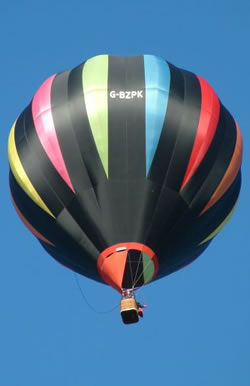Activity: Float a Hot Air Balloon
 (Activity courtesy of the Federal Aviation Administration)
(Activity courtesy of the Federal Aviation Administration)
Up in the Air with Bag Balloons
Objectives
- Students demonstrate that heat can change air.
- Students determine that hot air rises.
- Students construct a working model of a hot air balloon.
Background
Hot air balloons are one of four types of aircraft (the other three categories being airplanes, gliders, and rotorcraft). In this activity, students construct a model of a hot air balloon and learn the dynamics and use of heated air in keeping these aircraft aloft.
There are two ways a balloon can rise. It can (1) be filled with a gas that is lighter than air, such as helium; or (2) it can be inflated with air that is heated sufficiently to make it “lighter” than the air outside of the balloon.
Helium is the second-lightest element, and the main sources for helium are natural gas fields, especially those in the states of Texas, Oklahoma, and Kansas. Heating air makes it less dense, rendering it essentially “lighter.” Gas balloons and hot air balloons float because they are lighter than the air they displace.
Materials
- Plastic bag (dry cleaners bags or 5-gallon trash bags work well)
- Paper clips (used as weights)
- Small pieces of paper or stickers for decoration
- String
- A hair dryer (heat source)
- Party balloons
Procedure
1. Divide the class into groups of four and provide each team with a set of materials, explaining the different parts of the hot air balloon: plastic bag—hot air balloon; hair dryer—heat source; paper clips—weights for balance and stability.
2. Have the students decorate their plastic bags. Decorations should be small and light, such as small scraps of paper or stickers.
3. Have the students tie a string around the top of the plastic bag.
4. Each group should now add paper clips spaced evenly around the bottom of their plastic bag.
5. Have the student groups take turns holding the plastic bag over the hair dryer, turning the dryer on its highest setting, and allowing the plastic bag fill with hot air.
6. The plastic bag will become buoyant as it fills with hot air. When the students feel the bag tugging, have them release it. The hot air inside the balloon is lighter than the air in the classroom and begins to float.
Discussion
- Ask the students to explain why the hot air balloon works. The hot air balloon rises when the air inside the balloon becomes heated. The heated air is lighter than the classroom air and enables the balloon to float.
- Ask the students to discuss how hot air balloons are different from balloons filled with helium. Helium is a gas that is lighter than air, even when it’s not heated. Just like heated air, however, helium floats in the surrounding air because it’s lighter. Helium should not be confused with hydrogen, which is an inflammable gas that was often used in balloons and airships until the explosion of the airship Hindenburg in 1937.
- Have the students inflate a party balloon and explain why it does not rise. A person’s breath may be warmer than room temperature, but it is not hot enough to overcome the weight of the balloon.
Assessment
- Using their actual models, have the students explain why their hot air balloons rise.
Extension
- Have the students construct another hot air balloon using different sizes and types of plastic bags.
- Have students experiment with paper clips — different sizes and numbers — to see the effects of weight on their model balloons. How can they refine their designs for better performance, or alter the designs for different results?
- Have the students research the part that balloons played in the history of flight.
- Have students explore current uses of hot air balloons, from entertainment and tourist rides to weather and research balloons, as well as ongoing plans by the U.S. government to develop military airships.
Filed under: Class Activities, Grades 6-8
Tags: Class Activities, Physical Science, Physics









